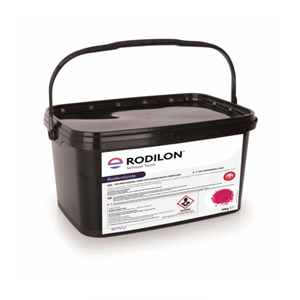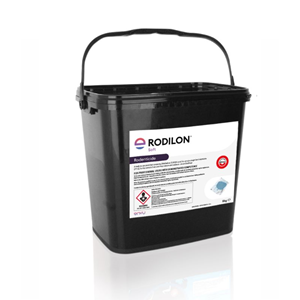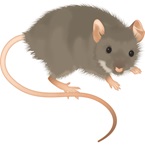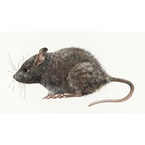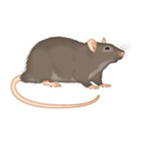Family: Muridae
Characteristics:
Brownish or greyish rodents with a tail approximately as long as the body. Omnivorous, often live in or around buildings.
Species characteristics:
Norway Rat (Rattus norvegicus)- Common names are Norway rat, Common rat and Brown rat.
- Adults: 220-260mm long
- Tail length 160-200mm
- Weight 150-450g
- Droppings are approx 20mm long
- Upper brown body with a white, yellowish belly
- Common names are Ship rat, Roof rat or Black rat.
- Adults: 180-230mm long
- Tail length 180-240mm long
- Weight 120-300g
- Droppings are approx 12mm long
- Despite its name it is usually black to light brown in colour with a lighter underside.
- Common name is the House mouse.
- Adults: 60-90mm
- Tail length 80-100mm long
- Weight 15g-33g max
- Droppings are approx 3-6mm long
Areas where found:
Norway Rat (Rattus norvegicus)
The Norway rat originated from Central to East Asia. It is thought to have arrived in Europe later than the Black rat, c. 16-17th century.
Black Rat (Rattus rattus)
The Black rat originated from India to Eastern Africa and was introduced into Europe over 2,000 years ago. The Black rat can now be found worldwide.
House Mouse (Mus musculus)
The House mouse originated from East-Asia and has spread throughout the world in distributed grain and food.
Human health
- Carriers of over 45 types of diseases including spirochaetes causing Weil’s Disease (Leptospirosis), Salmonella, E.coli, enteritis, listeriosis, rickettsiosis, dysentery and many others.
- Contamination of water and food
- Contamination of environment
Direct food losses
- Field crop losses
- Stored food and food prod. chain losses
Indirect food losses
- Packaging destruction, spillage
- Contamination with faeces
Construction
Damages in buildings:
- in sewers, dikes etc.
- in electric facilities and cables
- in communication
Animal production
- Feed losses and spillage
- Vector and reservoir of pathogens
Lifecycle:
Norway Rat (Rattus norvegicus)
The Norway rat reaches sexual maturity in about 2-3 months and are reproductive for one year. Norway rats can breed throughout the year if conditions are suitable. The gestation period is only 21 days and a female can produce up to a maximum of five litters a year. 14 pups per litter is the maximum, although six is the average.
Black Rat (Rattus rattus)
The Black rat’s live-cycle is very similar to the Norway rat, but it may live longer.
House Mouse (Mus musculus)
The House mouse reaches sexual maturity at 35-40 days. Outdoors they will breed throughout the summer only and indoors they will breed continuously. The gestation period is 19-21 days and a female can produce up to a maximum of 10 litters a year. 20 pups per litter is the maximum, although six is the average.
An integrated pest management approach using a combination of control measures (e.g. improving hygiene, proofing) is necessary in order to gain control of a rodent infestation. Baiting alone is not sufficient. To effectively control rat and mouse problems there are six golden rules which should be followed:
Inspection / Assessment of infestation
A thorough survey of the infested site before treatment begins is an essential key to success when using any rodenticide. It is important to determine the exact source of the infestation so that the problem can be tackled at source. Typical signs of an infestation are the smudge marks left by a rodent’s oily hair, its droppings and any damage to goods or structures. Draw up a simple site plan or location list identifying areas of particular concern pertinent to the site and retain this on file.
a) Identification
Rats and mice have significantly different behaviour patterns and need to be controlled in different ways. It is important to identify the species of the infestation so that the correct tactics can be employed to eliminate the problem. An inspection of the droppings can help in the identification.
b) Use an effective bait
Rodenticides with good palatability used correctly and in accordance with the CRRU (Campaign for Responsible Rodenticide Use) Code can be used to control rat or mice infestations.
c) Remain vigilant
Once an infestation has been controlled there will always be new rodents waiting to move into the same territory, always monitor for new activity and begin a baiting programme as soon as possible.
d) Sanitation
Removing the rodents’ food sources is a key factor in successful rodent control. Rubbish, food or feed should be stored where possible in sealed containers. Outside debris and vegetation particularly where it is in contact with a building should be removed. In addition try to reduce the number of water sources where rodents are able to drink from.
e) Rodent proofing
Keeping rodents out of buildings by closing off the typical places where they can gain access is a key factor in good rodent control. Try to close all holes in external walls, reinforce the base of wooden doors with metal strips to prevent gnawing and access, install self closing devices on doors that are frequently used.

